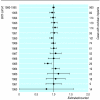Prevalence of permanent childhood hearing impairment in the United Kingdom and implications for universal neonatal hearing screening: questionnaire based ascertainment study
- PMID: 11546698
- PMCID: PMC48157
- DOI: 10.1136/bmj.323.7312.536
Prevalence of permanent childhood hearing impairment in the United Kingdom and implications for universal neonatal hearing screening: questionnaire based ascertainment study
Abstract
Objective: To estimate the prevalence of confirmed permanent childhood hearing impairment and its profile across age and degree of impairment in the United Kingdom.
Design: Retrospective total ascertainment through sources in the health and education sectors by postal questionnaire.
Setting: Hospital based otology and audiology departments, community health clinics, education services for hearing impaired children.
Participants: Children born from 1980 to 1995, resident in United Kingdom in 1998, with severe permanent childhood hearing impairment (hearing level in the better ear >40 dB averaged over 0.5, 1, 2, and 4 kHz).
Main outcome measures: Numbers of cases with date of birth and severity of impairment converted to prevalences for each annual birth cohort (cases/1000 live births) and adjusted for under ascertainment.
Results: 26 000 notifications ascertained 17 160 individual children. Prevalence rose from 0.91 (95% confidence interval 0.85 to 0.98) for 3 year olds to 1.65 (1.62 to 1.68) for children aged 9-16 years. Adjustment for under ascertainment increased estimates to 1.07 (1.03 to 1.12) and 2.05 (2.02 to 2.08). Comparison with previous studies showed that prevalence increases with age, rather than declining with year of birth.
Conclusions: Prevalence of confirmed permanent childhood hearing impairment increases until the age of 9 years to a level higher than previously estimated. Relative to current yields of universal neonatal hearing screening in the United Kingdom, which are close to 1/1000 live births, 50-90% more children are diagnosed with permanent childhood hearing impairment by the age of 9 years. Paediatric audiology services must have the capacity to achieve early identification and confirmation of these additional cases.
Figures



Comment in
-
Measuring the prevalence of permanent childhood hearing impairment.BMJ. 2001 Sep 8;323(7312):525-6. doi: 10.1136/bmj.323.7312.525. BMJ. 2001. PMID: 11546682 Free PMC article. No abstract available.
-
Doctors' management should not make things worse for patients.BMJ. 2002 Jan 19;324(7330):172-3. doi: 10.1136/bmj.324.7330.172a. BMJ. 2002. PMID: 11799041 Free PMC article. No abstract available.
-
Prevalence of permanent childhood hearing impairment. Family friendly hearing services are needed in the United Kingdom.BMJ. 2002 Jan 19;324(7330):172. BMJ. 2002. PMID: 11822343 Free PMC article. No abstract available.
-
Prevalence of permanent childhood hearing impairment. Pilot programme in Australia shows promising results.BMJ. 2002 Jan 19;324(7330):172. BMJ. 2002. PMID: 11822344 No abstract available.
References
-
- Conrad R. The deaf schoolchild: language and cognitive function. London: Harper and Row; 1979.
-
- Wood D, Wood H, Griffiths A, Howarth I. Teaching and talking with deaf children. Chichester: Wiley; 1986.
-
- Gregory S. Deaf children and their families. Cambridge: Cambridge University Press; 1995.
-
- Cheng AK, Rubin HR, Powe NR, Mellon NK, Francis HW, Niparko JK. Cost-utility analysis of the cochlear implant in children. JAMA. 2000;284:850–856. - PubMed
-
- Mohr PE, Feldman JJ, Dunbar JL, McConkey-Robbins A, Niparko JK, Rittenhouse RK, et al. The societal costs of severe to profound hearing loss in the United States. Int J Technol Assess. 2000;16:1120–1135. - PubMed
Publication types
MeSH terms
LinkOut - more resources
Full Text Sources
Medical
Miscellaneous
